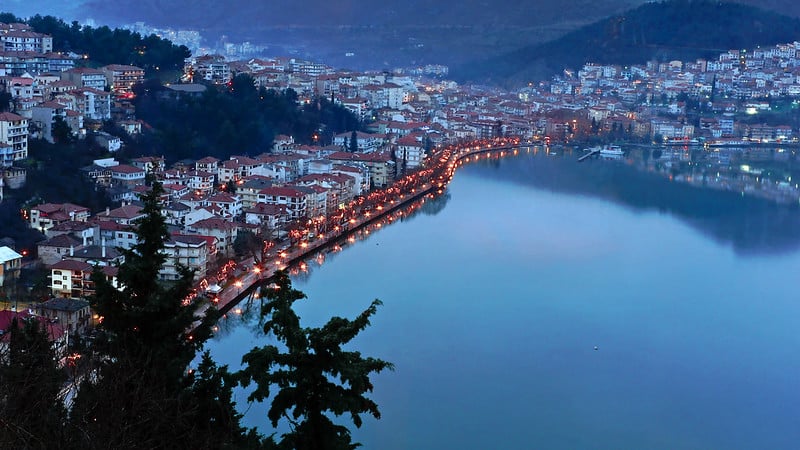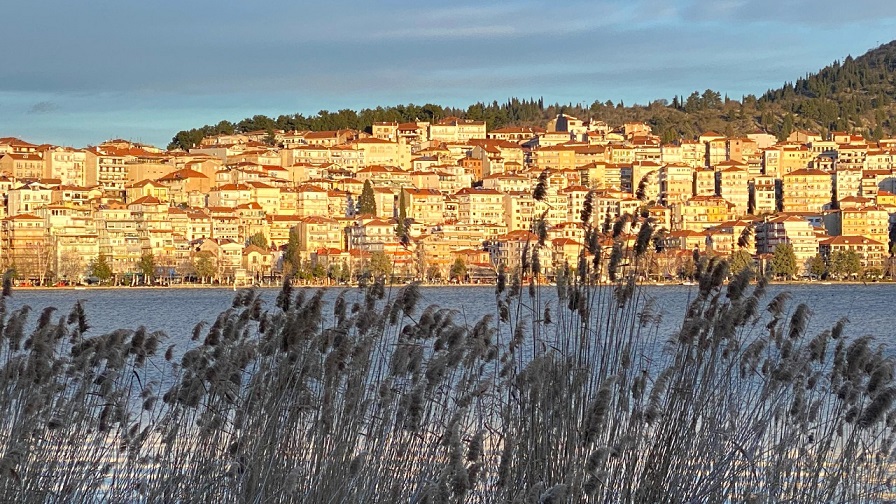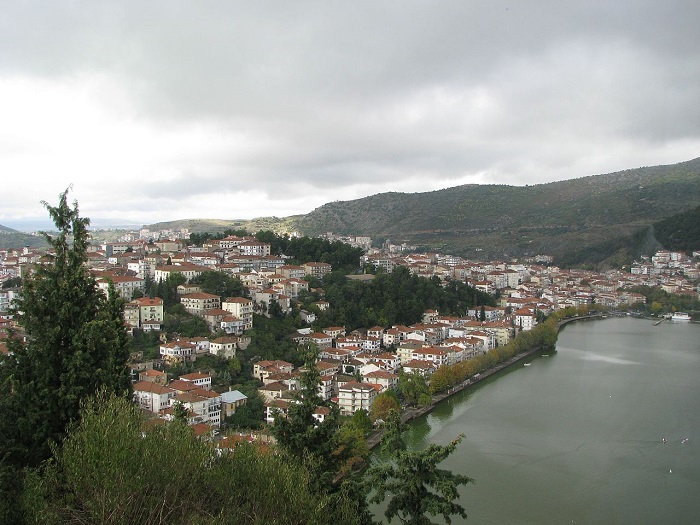
Kastoria is a magnificent lakeside city in northwestern Greece with a rich history dating back to Byzantium.
The capital of the Western Macedonia Prefecture with the same name, Kastoria is one of the most ambient cities in Greece, where the beautiful landscape is an integral part of the urban fabric.
The magnificent mansions built by wealthy merchants all across the city are proof of its great prosperity, as it has developed a strong economic and cultural identity thanks to the fur industry.
Kastoria was once famous for its fur and leather trade, but it has now almost completely stopped. The city perches quietly on the shores of the beautiful Οrestiada Lake. Yet, it remains the place of the largest fur exhibition in the world once a year.
Between the old mansions and modern apartment buildings, the historic Byzantine monuments make Kastoria look like an open-air Byzantine museum.

The old and the new in perfect harmony
The Kastoria visitor will admire Byzantine churches next to new apartment buildings and old mansions; see old cafes and alternative cafes right next to each other; visit gourmet restaurants next to 80-year-old eateries; and browse stores selling fur and leather goods.
The south bank of Orestiada Lake is busy all day and all night long. In the morning, the fresh lake air mixes with the smell of freshly brewed coffee from the cafes.
If you wake up early in the morning and walk close to the lake, you will experience the wonderful fog that embraces Kastoria until the sun comes up.
In the evening, the music from the cafes and bars outdoes the cries of swans and ducks while the lights sparkle on the dark lake.
Further inside the city, the cobbled streets and the mansions of the furriers alternate with funky bars and ultra-modern shops.
While you walk the Kastoria streets, you will definitely stumble upon one of the seventy Byzantine and post-Byzantine churches, with the oldest one dating from the 11th century.
Most of the churches are nestled in between homes, as they are family chapels with rare frescoes inside; they have beautiful exterior decor, as well.
Kastoria is charming throughout the year. From the walks along the frozen lake in Winter to the Springtime walks on its banks under the green plane and oak trees, Orestiada Lake is always the highlight.
Popular festivals there are the Ragoutsaria, the most important historic cultural event of Kastoria, with masquerades, music and dances from Epiphany until the Feast of Saint Dominic on January 8.
The famous River Party festival at the foot of Grammos Mountain in the springs of the Aliakmonas River is also a must. Famous musicians and people coming to the city from all over Greece make it an unforgettable event.

A city built by the fur trade
For centuries, tradesmen in Kastoria were organized in professional unions or guilds. The most famous was and still is the furriers guild. The point of origin of fur processing in the area is unknown. Some place it in the Byzantium era while others back in antiquity and yet others in the 15th century.
Today, trading in mink predominates in Kastoria and is the biggest generator of income in its economy. An international fur showcase takes place annually in the city.
The fur trade started at least as far back as the 14th century when the city provided the ermine pelts for the lining of the robes of the Byzantine courtiers.
Early Kastoria fur merchants settled in Russia and Germany. After Germany’s division at the end of World War II, the fur center moved from Leipzig to Frankfurt.
During the Greek Civil War, thousands of Kastorians migrated to the United States to take the place of aging Jewish immigrants who had formed the core of the New York furriers earlier in the 1900s.
In 1984, an incredible 25,000 Kastorians were working and living in the New York area while about 10,000 resided in Frankfurt, Germany.
Now there are more than 300 small and major fur dealers in Kastoria. Other industries include the sale and distribution of locally grown produce, especially apples, wine, and fish.

The rich history of Kastoria
The “Byzantine noblewoman,” as it was called in the old days, Kastoria took its name from the countless castors (beavers) that once lived there.
The beginning of human habitation in the area goes back to the Neolithic era, as proven by archaeological excavations, which brought to light the remains of a lake settlement in the adjacent Dispilio community.
Kastoria was occupied by the Romans after a siege which occurred around 200 BC. Seven centuries later, Byzantine Emperor Justinian, while passing through the area, asked that a new city be built on that spot.
The new city of Kastoria was fortified with a stout wall, part of which survives to this day. This is why some believe that the name of the city actually comes from the word Κάστρο (castle).
During the 10th to 11th centuries, Kastoria was occupied by Bulgarians and Normans, and in 1204, after the Fall of Constantinople, by the Franks.
From the 12th to the 14th century, it was the center of the Despotate of Epirus and part of the territory of the Empire of Nicaea. After the recapture of Constantinople, it joined the Byzantine Empire once again.
During these centuries (mainly in the 11th century) many Byzantine churches were built which became cultural points of reference for the following generations.
Today, twelve churches from that period remain preserved, among which are Panagia Koumbelidiki, the iconic church of Kastoria, and the church of Taxiarches. Post-Byzantine churches were built between the 15th and 19th centuries, as well.

Kastoria under Ottoman rule
In 1380, Kastoria came under the rule of the Serbs and was occupied by the Ottomans in 1385.
During the Ottoman occupation, the city acquired a kind of self-government thanks to the privileges given to it by the Sublime Porte.
Its supreme ruler was the Orthodox Metropolitan, who had the support of the Ottoman administration.
During that period, its population ranged between 15,000 and 20,000, among which were Jews and a few Ottoman warrior settlers.
However, there were prominent Kastorians who, feeling oppressed, fled to Europe, where many of them stood out through success in trade or through the struggle against the conquerors.
Some of these rebels were the brothers Panagiotis and Ioannis Emmanouil, who, having embraced the ideas of one of the architects of the Revolution, Rigas Feraios Velestinlis, did not hesitate to follow him to his martyrdom.

See all the latest news from Greece and the world at Greekreporter.com. Contact our newsroom to report an update or send your story, photos and videos. Follow GR on Google News and subscribe here to our daily email!



